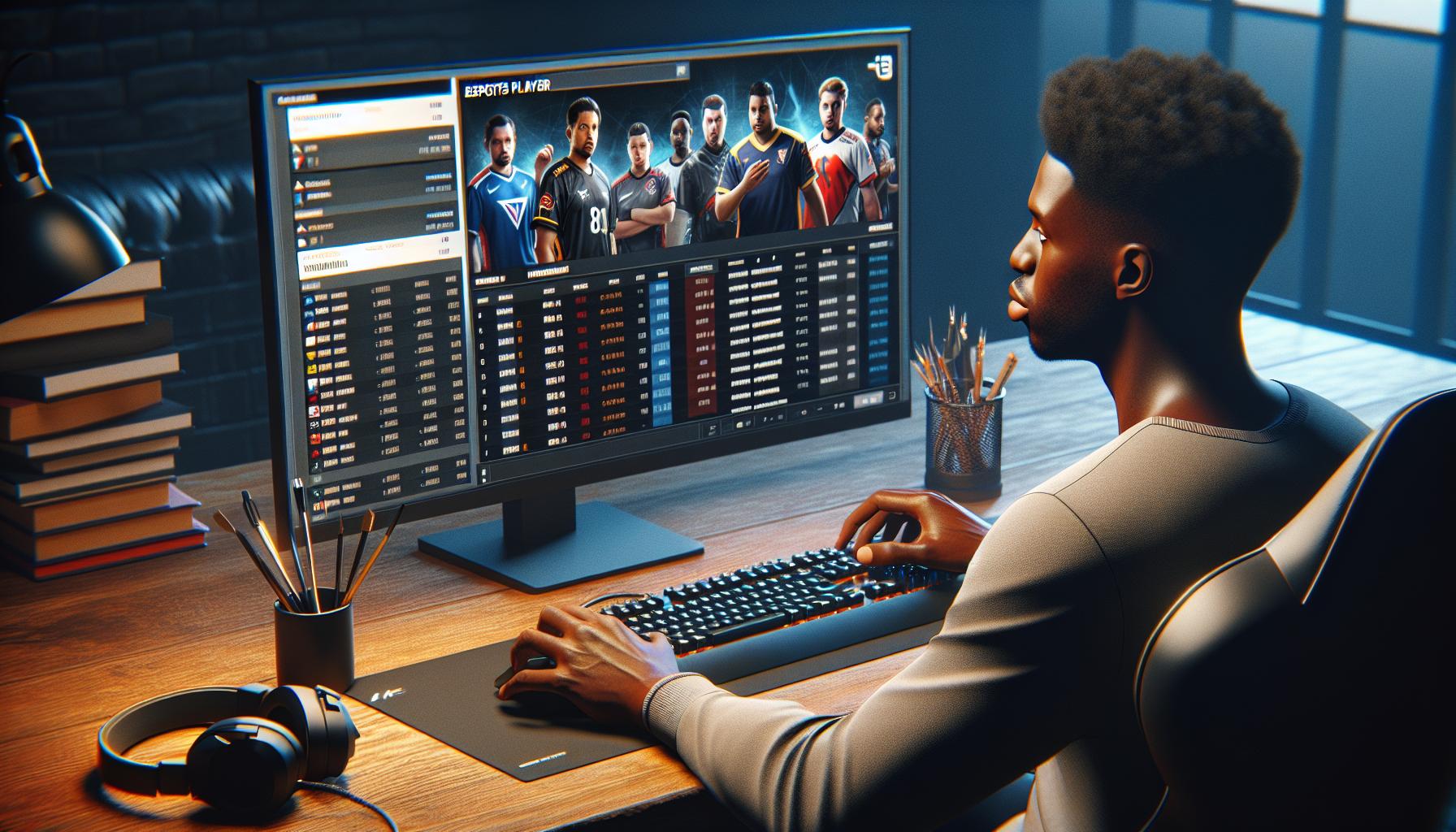Esports Fantasy: Ultimate Guide to Building Championship Teams in Pro Gaming Leagues

I’ve watched esports evolve from humble beginnings into a billion-dollar industry, and one of the most exciting developments has been the rise of esports fantasy leagues. Just like traditional sports fantasy leagues, these digital competitions let fans draft their dream teams of professional gamers and compete based on real tournament performances.
As a long-time fantasy sports enthusiast, I find esports fantasy particularly fascinating because it combines statistical analysis with the dynamic world of competitive gaming. Whether you’re following League of Legends, CS:GO, or Dota 2, there’s an opportunity to showcase your knowledge and prediction skills while competing against other fans. The growing popularity of these platforms has created an entirely new way to engage with esports, transforming passive viewers into active participants in the competitive gaming ecosystem.
Key Takeaways
- Esports fantasy gaming allows fans to create virtual teams using professional gamers, earning points based on real tournament performances
- Key differences from traditional fantasy sports include tournament-based scoring, game-specific metrics, and more frequent roster updates compared to seasonal formats
- Major platforms like DraftKings, FanDuel, and ESL Fantasy offer various entry options, from free-to-play to premium contests, with real-time score tracking
- Successful roster building requires allocating 40-45% of budget to core players, analyzing team performance metrics, and maintaining consistent player stats like K/D ratios above 1.5
- Different games use unique scoring systems – League of Legends focuses on KDA, CS:GO tracks kills and headshots, while Dota 2 incorporates multiple gameplay metrics
- Major tournaments offer significant prize pools, with competitions like LoL Worlds Fantasy featuring up to $100,000 in prizes and various reward structures
What Is Esports Fantasy Gaming
Esports fantasy gaming recreates the competitive excitement of professional gaming through virtual team management. Players build rosters of pro gamers across different esports titles to earn points based on tournament performance metrics.
How Traditional Fantasy Sports Differ From Esports Fantasy
Traditional fantasy sports focus on season-long statistics while esports fantasy operates on tournament-based scoring systems. Here are the key differences:
- Roster Construction: Traditional sports require full team positions (QB, RB, WR) while esports rosters focus on individual player roles (Mid, ADC, Support)
- Scoring Frequency: Traditional leagues update weekly during regular seasons whereas esports scoring updates multiple times during tournament matches
- Performance Metrics: Traditional sports track standard statistics (yards, points, assists) while esports measure game-specific metrics (CS, KDA, GPM)
- Season Structure: Traditional leagues follow fixed regular seasons while esports adapts to tournament schedules throughout the year
- Draft Format: Traditional drafts happen once per season while esports allows frequent roster changes between tournaments
- League of Legends Fantasy
- Points based on kills, deaths, assists (KDA)
- Player values fluctuate based on tournament performance
- Features both LCS NA LEC EU leagues
- CS:GO Fantasy
- Scoring includes kills, headshots, clutch rounds
- Options for daily, weekly tournament lineups
- Covers major events like ESL DreamHack tournaments
- Dota 2 Fantasy
- Complex scoring incorporating 10+ gameplay metrics
- Dedicated Fantasy DPC system integrated in-game
- Tracks professional circuit tournaments worldwide
- Overwatch Fantasy
- Role-specific scoring for Tank, DPS Support positions
- Seasonal leagues aligned with Overwatch League schedule
- Team-based bonus points for map objective completion
Getting Started With Esports Fantasy

Starting your esports fantasy journey requires selecting a platform that aligns with your favorite games and understanding how players earn points during competitions.
Choosing The Right Platform
DraftKings Fantasy Esports offers daily contests focused on League of Legends. FanDuel features Counter-Strike tournaments with immediate payouts. ESL Fantasy provides game-specific leagues for Dota 2 tournaments. Each platform delivers unique features:
- Entry fees range from free-to-play to $100+ premium contests
- User interfaces display real-time score tracking during live matches
- Mobile apps enable roster management from any location
- Payment options include PayPal, credit cards or cryptocurrency
- Customer support responds through live chat, email or phone
Understanding Scoring Systems
Different esports titles use distinct scoring metrics based on game mechanics:
| Game | Key Scoring Categories | Points Per Action |
|---|---|---|
| LoL | Kills/Deaths/Assists | 3/0/1 |
| CS:GO | Kills/Headshots/Clutches | 2/1/4 |
| Dota 2 | Kills/Tower Destruction/GPM | 3/2/0.1 |
| Overwatch | Eliminations/Healing/Objective Time | 1/0.001/0.1 |
Performance bonuses apply for:
- Achieving multi-kills in a single round
- Maintaining high CS (creep score) rates
- Securing map objectives like dragons or towers
- Winning MVP awards in tournament matches
- Setting damage or healing records per game
Regular monitoring of patch updates impacts scoring changes as game mechanics evolve.
Player Selection Strategy

Player selection in esports fantasy requires data-driven decision-making focused on consistent performance metrics across tournaments.
Researching Team Performance
Professional team dynamics directly impact individual player performance in esports fantasy leagues. I analyze team win rates, map preferences, tournament schedules, roster stability during the past 3 months. Teams with 65%+ win rates on specific maps often yield higher fantasy points through objective control bonuses. Core statistical indicators include:
- Match history against specific opponents from recent tournaments
- Average game duration (shorter games = fewer potential points)
- Team playstyle alignment with current meta strategies
- Recent roster changes or substitutions affecting team synergy
- Tournament format impact on team performance (BO1 vs BO3)
- K/D/A ratios in last 20 professional matches
- Average fantasy points per game across tournaments
- Role-specific metrics:
- CS:GO: Headshot percentage entry frags utility damage
- LoL: CS per minute vision score objective control
- Dota 2: GPM tower damage ward placement
- Player consistency scores in high-stakes matches
- Performance trends against specific opponents
- Historical fantasy point production in similar tournament formats
| Key Performance Metrics | Minimum Threshold | Target Range |
|---|---|---|
| Match Participation | 85% | > 90% |
| K/D Ratio | 1.0 | > 1.5 |
| Fantasy Points/Match | 20 | > 25 |
| Win Rate | 55% | > 60% |
Building Your Fantasy Roster

Effective roster construction in esports fantasy requires strategic player selection combined with calculated budget allocation across different positions. Here’s how to maximize your roster’s potential through budget management and draft strategies.
Budget Management Tips
I allocate my fantasy budget based on these proven guidelines:
- Reserve 40-45% for core players who generate consistent points through high K/D ratios above 1.5
- Set aside 30-35% for flex positions that can adapt to meta changes across tournaments
- Keep 15-20% for value picks who outperform their salary expectations
- Maintain 5-10% as a buffer for last-minute roster adjustments
| Position Type | Budget Allocation | Minimum Performance Metrics |
|---|---|---|
| Core Players | 40-45% | K/D > 1.5, 80%+ map presence |
| Flex Players | 30-35% | K/D > 1.2, 70%+ map presence |
| Value Picks | 15-20% | K/D > 1.0, 60%+ map presence |
| Buffer | 5-10% | N/A |
- Pick team captains from top 3 ranked teams in tournament standings
- Target players with 85%+ match participation rates in previous tournaments
- Select support roles from teams with positive win rates on multiple maps
- Focus on entry fraggers in FPS games with opening kill rates above 65%
- Choose players from teams scheduled for multiple matches in a game week
| Draft Priority | Selection Criteria | Target Metrics |
|---|---|---|
| First Round | Team Captains | Top 3 ranked teams |
| Second Round | Core Players | 85%+ participation |
| Mid Rounds | Support Roles | 60%+ win rate |
| Late Rounds | Value Picks | 65%+ specific role stats |
Major Esports Fantasy Tournaments
Major esports tournaments feature dedicated fantasy leagues with significant prize pools across multiple game titles. These competitions align with premier events in the competitive gaming calendar.
Seasonal Competitions
- DreamHack Masters hosts quarterly fantasy leagues for CS:GO with 10,000+ participants per season
- ESL Pro League runs bi-annual fantasy competitions across 3 regions: Europe, North America & Asia
- League of Legends World Championship Fantasy spans 4 weeks with daily roster updates
- The International Dota 2 Fantasy Challenge features 2 distinct phases: group stage & main event
- BLAST Premier organizes 3 seasonal tournaments with integrated fantasy leagues
- Overwatch League Fantasy operates through a 27-week regular season format
| Tournament | Prize Pool | Entry Fee | Top Prize |
|---|---|---|---|
| ESL Pro League Fantasy | $50,000 | Free | $15,000 |
| DreamHack Fantasy | $25,000 | $5-$50 | $7,500 |
| LoL Worlds Fantasy | $100,000 | Free-$100 | $25,000 |
| TI Fantasy Challenge | 50,000 Battle Pass Points | Battle Pass Required | 10,000 BP Points |
| BLAST Fantasy | $15,000 | $10-$25 | $5,000 |
| OWL Fantasy | $30,000 | Free | $10,000 |
- Free-to-play tournaments offer Battle Pass points, exclusive skins & in-game items
- Premium leagues include cash prizes, tournament tickets & gaming peripherals
- Monthly qualifier tournaments provide entry tickets to major events
- Special event competitions feature unique rewards like team merchandise & signed memorabilia
- Season-long leagues distribute weekly payouts to top performers
- Regional tournaments offer localized prizes based on participation numbers
Conclusion
Esports fantasy has revolutionized how fans engage with competitive gaming by creating an immersive experience that combines strategic thinking with deep game knowledge. I’ve seen firsthand how this rapidly growing segment has transformed casual viewers into dedicated analysts who closely follow player statistics and team dynamics.
Whether you’re a seasoned fantasy sports veteran or new to the esports scene the opportunities for engagement and competition are endless. The key to success lies in understanding your chosen game’s mechanics staying updated with tournament schedules and making data-driven decisions for your roster.
As esports continues to evolve I expect fantasy platforms to introduce even more innovative features and gameplay elements. Now’s the perfect time to dive in and become part of this exciting blend of competitive gaming and strategic team management.



